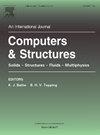An analytical approach to the sensitivity analysis of semi-recursive ODE formulations for multibody dynamics
IF 4.4
2区 工程技术
Q1 COMPUTER SCIENCE, INTERDISCIPLINARY APPLICATIONS
引用次数: 0
Abstract
Sensitivity analysis is an extremely powerful tool in many applications such as in the optimization of the dynamics of multibody systems with gradient-based methods. Sensitivity calculations are computationally burdensome and, depending on the method chosen for differentiation and the set of dynamic equations, they could result highly inefficient. Semi-recursive dynamic methods are seldom studied analytically in terms of sensitivity analysis due to their complexity, even though their dynamic performance is usually among the most efficient.
This work explores the sensitivity analysis of a particular multibody-dynamics formulation, the semi-recursive Matrix R formulation, which is based on the nullspace of constraint equations and leads to a system of ordinary differential equations. As a result, two sets of sensitivity equations are proposed, one based on the direct differentiation method (DDM) and other on the Adjoint Variable Method (AVM), being these sensitivity formulations the main novelty of this work. The main derivatives required in the sensitivity equations are listed in this document, paying special attention to conciseness, correctness and completeness. The methods proposed have been implemented in the general purpose multibody library MBSLIM (Multibody Systems in Laboratorio de Ingeniería Mecánica), and their performance has been tested in two numerical experiments, a five-bar benchmark problem and a four-wheeled buggy vehicle.
A review and generalization of constrained and unconstrained kinematic problems in relative coordinates is provided as an introduction to the generation of the semi-recursive Matrix R equations of motion. Due to the importance of the selection of the set of independent coordinates, a more general description of the Matrix R method is presented as a novel contribution as well.
多体动力学半递归ODE公式灵敏度分析的解析方法
灵敏度分析在许多应用中都是极为强大的工具,例如在使用基于梯度的方法优化多体系统动力学时。灵敏度计算是一项繁重的计算工作,而且根据所选的微分方法和动态方程组的不同,灵敏度计算的效率可能非常低。尽管半递归动态方法的动态性能通常是最高效的,但由于其复杂性,很少从灵敏度分析的角度对其进行分析研究。
本文章由计算机程序翻译,如有差异,请以英文原文为准。
求助全文
约1分钟内获得全文
求助全文
来源期刊

Computers & Structures
工程技术-工程:土木
CiteScore
8.80
自引率
6.40%
发文量
122
审稿时长
33 days
期刊介绍:
Computers & Structures publishes advances in the development and use of computational methods for the solution of problems in engineering and the sciences. The range of appropriate contributions is wide, and includes papers on establishing appropriate mathematical models and their numerical solution in all areas of mechanics. The journal also includes articles that present a substantial review of a field in the topics of the journal.
 求助内容:
求助内容: 应助结果提醒方式:
应助结果提醒方式:


